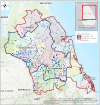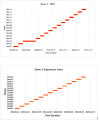Gatekeeper training for vendors to reduce pesticide self-poisoning in rural South Asia: a study protocol for a stepped-wedge cluster randomised controlled trial
- PMID: 35379621
- PMCID: PMC8981379
- DOI: 10.1136/bmjopen-2021-054061
Gatekeeper training for vendors to reduce pesticide self-poisoning in rural South Asia: a study protocol for a stepped-wedge cluster randomised controlled trial
Abstract
Introduction: Pesticide self-poisoning kills an estimated 110 000-168 000 people worldwide annually. Data from South Asia indicate that in 15%-20% of attempted suicides and 30%-50% of completed suicides involving pesticides these are purchased shortly beforehand for this purpose. Individuals who are intoxicated with alcohol and/or non-farmers represent 72% of such customers. We have developed a 'gatekeeper' training programme for vendors to enable them to identify individuals at high risk of self-poisoning (gatekeeper function) and prevent such individuals from accessing pesticides (means restriction). The primary aim of the study is to evaluate the effectiveness of the gatekeeper intervention in preventing pesticide self-poisoning in Sri Lanka. Other aims are to identify method substitution and to assess the cost and cost-effectiveness of the intervention.
Methods and analysis: A stepped-wedge cluster randomised trial of a gatekeeper intervention is being conducted in rural Sri Lanka with a population of approximately 2.7 million. The gatekeeper intervention is being introduced into 70 administrative divisions in random order at each of 30 steps over a 40-month period. The primary outcome is the number of pesticide self-poisoning cases identified from surveillance of hospitals and police stations. Secondary outcomes include: number of self-poisoning cases using pesticides purchased within the previous 24 hours, total number of all forms of self-harm and suicides. Intervention effectiveness will be estimated by comparing outcome measures between the pretraining and post-training periods across the divisions in the study area. The original study protocol has been adapted as necessary in light of the impact of the COVID-19.
Ethics and dissemination: The Ethical Review Committee of the Faculty of Medicine and Allied Sciences, Rajarata University, Sri Lanka (ERC/2018/30), and the ACCORD Medical Research Ethics Committee, Edinburgh University (18-HV-053) approved the study. Results will be disseminated in scientific peer-reviewed journals.
Trial registration number: SLCTR/2019/006, U1111-1220-8046.
Keywords: public health; suicide & self-harm; toxicology.
© Author(s) (or their employer(s)) 2022. Re-use permitted under CC BY-NC. No commercial re-use. See rights and permissions. Published by BMJ.
Conflict of interest statement
Competing interests: KH is joint chair of the Prevention of Pesticide Self-Poisoning Special Interest Group of the International Association for Suicide Prevention. He declares having received a small grant from Syngenta for a study of safer storage of pesticides in Sri Lanka. DJG, FK and ME were expert advisers to WHO’s consultation on cost-effectiveness of suicide prevention interventions, including pesticide regulation (Geneva, 2019). They provided technical assistance for the development and publication of Preventing Suicide: A Resource Guide for Pesticide Registrars and Regulators (WHO, May–June 2019). DJG was a member of the scientific advisory group for a Syngenta-funded study to assess the toxicity of a new paraquat formulation (2002–2006); a member of the scientific advisory group for a pesticide storage project funded by Syngenta (2005–2007); and chaired the DMEC for a Syngenta-funded trial of the medical management of paraquat poisoning (2007–2010); he received travel costs to attend research meetings but no other fees. DJG was an expert adviser to WHO’s First Consultation on Best Practices on Community Action for safer access to pesticides (Geneva, 2006). ME is a WHO member of the FAO-WHO Joint Meeting on Pesticide Management and received an unrestricted research grant from Cheminova (2012) and travel expenses from Syngenta to attend study meetings (2005–2006). ME is affiliated with the Centre for Pesticide Suicide Prevention, which is funded by an Incubator Grant from the Open Philanthropy Project Fund, an advised fund of Silicon Valley Community Foundation, on the recommendation of GiveWell, USA.
Figures




Similar articles
-
Exploring fidelity of enactment in a cluster randomised controlled trial testing the effectiveness of 'gatekeeper' training for pesticide vendors in reducing self-poisoning in rural Sri Lanka: protocol for a multimethod qualitative study.BMJ Open. 2024 Jul 8;14(7):e082688. doi: 10.1136/bmjopen-2023-082688. BMJ Open. 2024. PMID: 38977371 Free PMC article.
-
Cost-effectiveness analyses of self-harm strategies aimed at reducing the mortality of pesticide self-poisonings in Sri Lanka: a study protocol.BMJ Open. 2015 Feb 27;5(2):e007333. doi: 10.1136/bmjopen-2014-007333. BMJ Open. 2015. PMID: 25724984 Free PMC article.
-
Vendor-based restrictions on pesticide sales to prevent pesticide self-poisoning - a pilot study.BMC Public Health. 2018 Feb 20;18(1):272. doi: 10.1186/s12889-018-5178-2. BMC Public Health. 2018. PMID: 29463230 Free PMC article.
-
How many premature deaths from pesticide suicide have occurred since the agricultural Green Revolution?Clin Toxicol (Phila). 2020 Apr;58(4):227-232. doi: 10.1080/15563650.2019.1662433. Epub 2019 Sep 9. Clin Toxicol (Phila). 2020. PMID: 31500467 Review.
-
Suicides by pesticide ingestion in Pakistan and the impact of pesticide regulation.BMC Public Health. 2023 Apr 11;23(1):676. doi: 10.1186/s12889-023-15505-1. BMC Public Health. 2023. PMID: 37041526 Free PMC article. Review.
Cited by
-
Exploring fidelity of enactment in a cluster randomised controlled trial testing the effectiveness of 'gatekeeper' training for pesticide vendors in reducing self-poisoning in rural Sri Lanka: protocol for a multimethod qualitative study.BMJ Open. 2024 Jul 8;14(7):e082688. doi: 10.1136/bmjopen-2023-082688. BMJ Open. 2024. PMID: 38977371 Free PMC article.
-
"Ad hoc policy decisions" in the news: Media framing analysis of a pesticide import ban in Sri Lanka.PLOS Glob Public Health. 2024 Jul 16;4(7):e0003497. doi: 10.1371/journal.pgph.0003497. eCollection 2024. PLOS Glob Public Health. 2024. PMID: 39012886 Free PMC article.
-
Pharmacist gatekeeper interventions for suicide prevention: how evidence from developed countries support their role in low- and middle-income countries.Front Psychiatry. 2025 Jan 28;15:1508621. doi: 10.3389/fpsyt.2024.1508621. eCollection 2024. Front Psychiatry. 2025. PMID: 39935627 Free PMC article. Review.
-
Surveillance of pesticide poisoning in an East and a West Malaysian hospital: characteristics of pesticide poisoning and the early impact of a national Paraquat ban.BMC Psychiatry. 2023 Jun 28;23(1):472. doi: 10.1186/s12888-023-04974-8. BMC Psychiatry. 2023. PMID: 37380953 Free PMC article.
References
-
- World Health Organization . Preventing suicide: a global imperative. WHO, 2019.
Publication types
MeSH terms
Substances
LinkOut - more resources
Full Text Sources
Medical
